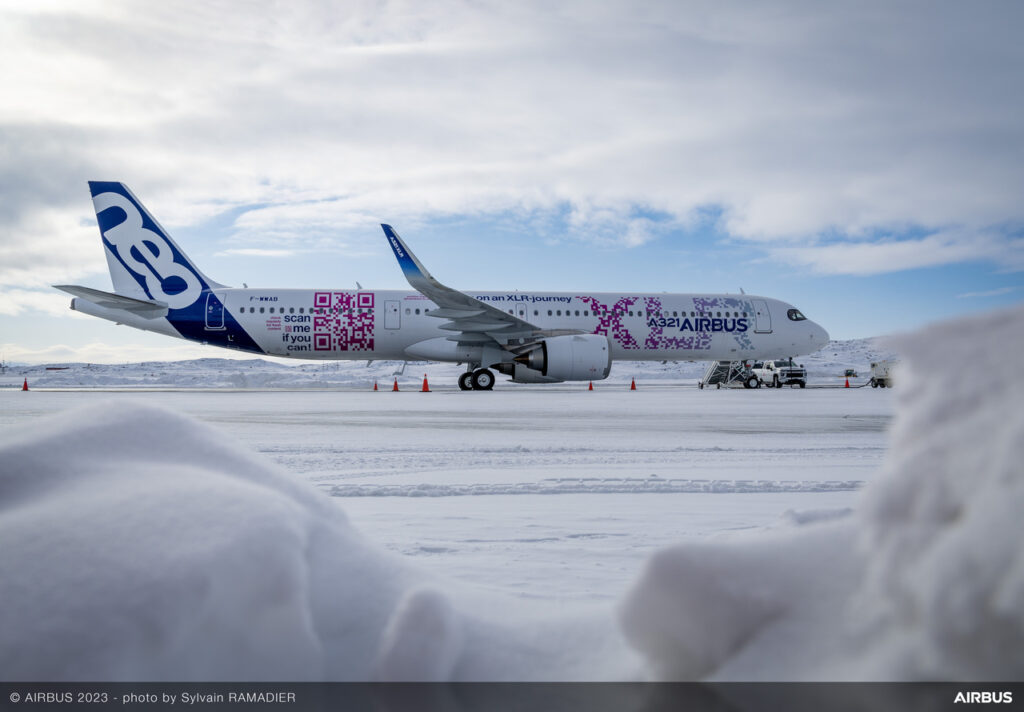Last week manufacturer Airbus noted on its social media channels that its A321XLR was completing a new set of extreme cold weather tests in Iqaluit, Canada.
In this article, we take a look at exactly what is involved with the cold weather testing of an airliner, and the various methods used to test them.
Airliners are complex machines that are designed to operate under a wide range of conditions, including extreme cold weather.
Testing airliners for cold weather operations is an important part of ensuring their safety and reliability, especially for airlines that operate in regions with harsh winter weather.

Cold Soak Testing
One of the most common tests used to evaluate an airliner’s cold weather performance is cold soak testing. This test involves exposing the aircraft to extremely low temperatures for an extended period of time, typically for at least 12 hours or longer.
During the test, the aircraft is left outside in the cold, and various systems are monitored to ensure they function properly.
The purpose of cold soak testing is to evaluate an aircraft’s ability to start and operate under cold conditions. This includes testing the performance of the engines, hydraulic systems, and electrical systems.
For example, the test may involve starting the engines at low temperatures to determine how long it takes for them to reach their operating temperature.
Icing Testing
Another important aspect of cold weather testing is evaluating an airliner’s performance in icing conditions.
Icing can form on an aircraft’s surfaces, such as the wings and engines, which can adversely affect the aircraft’s performance and handling characteristics.
To simulate icing conditions, a test aircraft is sprayed with water in a specially designed icing tunnel.
The water is chilled to below freezing temperatures to ensure it forms ice on the aircraft’s surfaces. The aircraft is then flown in a controlled environment to observe how the ice affects its performance and handling characteristics.
Engine Testing
Engines are critical components of any airliner, and they must be tested to ensure they can operate in cold weather conditions.
This includes starting the engines at low temperatures and testing their performance in cold weather.
During engine testing, the engines are monitored for performance and efficiency, as well as their ability to start and operate in cold conditions.
Fuel Testing
Fuel is another critical component of any airliner, and it must be tested to ensure it can operate in cold weather conditions.
This includes testing the fuel’s ability to flow at low temperatures and ensuring that fuel lines and pumps do not freeze.
Fuel testing is typically conducted in a controlled laboratory environment, where the fuel is chilled to below freezing temperatures to simulate cold weather conditions.
Cold Weather Flight Testing
Perhaps the most important aspect of testing airliners for cold weather operations is flying the aircraft in cold weather conditions.
This includes testing the aircraft’s ability to take off and land on snow-covered runways, as well as its ability to handle icing conditions.
During cold weather flight testing, the aircraft is flown in a controlled environment to evaluate its performance and handling characteristics.
This may involve conducting takeoff and landing operations on snow-covered runways, as well as evaluating the aircraft’s ability to handle icing conditions.
Conclusion
It’s worth noting that all major aircraft manufacturers conduct cold weather testing as part of their certification process.
This testing is typically conducted in a controlled environment, such as a cold weather chamber or icing tunnel, to simulate extreme cold weather conditions.
The testing evaluates various systems and components to ensure they function properly in cold weather conditions, including the aircraft’s engines, fuel systems, avionics, and flight control systems.
By conducting extensive cold weather testing, aircraft manufacturers can ensure that their airliners are safe and reliable to operate in even the most extreme weather conditions.
Airbus naturally conducts extensive cold weather testing on its aircraft, including the A320, A330, A350, and A380.
For example, during testing of the A350 XWB, Airbus conducted cold weather testing in northern Canada and Norway.
The testing evaluated the aircraft’s systems, engines, and avionics to ensure they functioned properly under extreme cold conditions, including testing the aircraft’s ability to start and operate in temperatures as low as minus 40 degrees Celsius.









